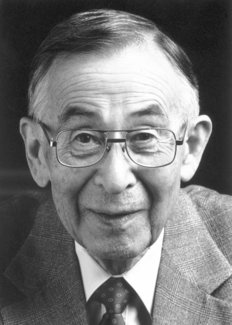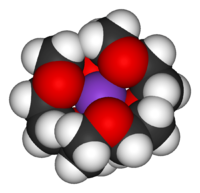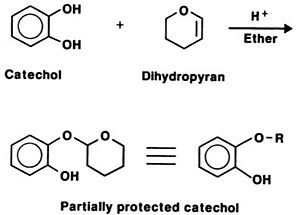Charles J. Pedersen facts for kids
Quick facts for kids
Charles John Pedersen
|
|
|---|---|
 |
|
| Born | October 3, 1904 |
| Died | October 26, 1989 (aged 85) Salem, New Jersey, U.S.
|
| Nationality | American |
| Alma mater | University of Dayton, Massachusetts Institute of Technology |
| Awards | Nobel Prize in Chemistry (1987) |
| Scientific career | |
| Fields | Organic chemistry |
| Institutions | DuPont |
Charles John Pedersen (安井 良男, Yasui Yoshio, October 3, 1904 – October 26, 1989) was an American chemist. He is famous for finding ways to make special molecules called crown ethers. He worked for the DuPont company for 42 years.
Pedersen shared the Nobel Prize in Chemistry in 1987. He won it with two other scientists, Donald J. Cram and Jean-Marie Lehn. He is the only Nobel Prize winner born in Korea for science.
Contents
Early Life and School
Charles J. Pedersen was born on October 3, 1904, in Busan, Korea. He was the youngest of three children. His father, Brede Pedersen, was a Norwegian engineer. His mother, Takino Yasui, was Japanese and traded soybeans and silkworms. They met near the Unsan County mines where his father worked.
Even though he lived in Korea, Charles grew up speaking mostly English. This was because he lived near American-owned mines.
When he was about 8 years old, Charles went to school in Japan. He studied in Nagasaki and then at St. Joseph College in Yokohama.
After finishing school in Japan, Pedersen decided to go to college in America. He attended the University of Dayton in Ohio.
At the University of Dayton, he studied chemical engineering. He was a very active student. He played on the varsity tennis team for four years and was even captain. He also helped with the Engineers’ Club and the school newspaper. He graduated in 1926.
Pedersen then went to the Massachusetts Institute of Technology (MIT). There, he earned a master's degree in organic chemistry. His professors wanted him to stay and get a PhD, but he decided to start working instead. He is one of the few people to win a Nobel Prize in science without having a PhD.
Working at DuPont
After MIT, Pedersen started working at the DuPont Company in Wilmington, Delaware, in 1927. DuPont is a very large chemical company. At DuPont, he was inspired by other great chemists and new discoveries in chemistry.
Pedersen was interested in solving real-world problems in chemistry. He focused on how to stop chemicals from breaking down and how to make them more stable. This work later led to his Nobel Prize discovery.
He retired at age 65. He had written 25 scientific papers and received 65 patents. In 1967, he published his important work on how to make crown ethers. These are special donut-shaped molecules. They were the first of their kind that could hold onto alkali metal ions (like sodium or potassium).
In 1987, he shared the Nobel Prize in Chemistry for this amazing work.
How Crown Ethers Were Discovered
Around 1960, Pedersen was studying how different chemicals connect to each other. A colleague suggested he work with a metal called vanadium. While doing this research, Pedersen accidentally found something new.
He was trying to clean a chemical compound. He noticed a strange "goo" that he couldn't get rid of. He used special tools to study this unknown substance. He found that it reacted in a unique way when he added alkali (a type of chemical base).
Pedersen then tried to dissolve the "goo" in methanol. It didn't dissolve. But when he added sodium salts (which contain sodium ions) to the methanol, the "goo" suddenly dissolved! This showed him that the substance was interacting with the sodium ions.
He realized this new molecule was similar to another one, but twice as big. He named it dibenzo-18-crown-6. This was the very first "crown compound" ever found.
Working with Other Scientists
Reed M. Izatt
In 1968, another scientist named Reed Izatt learned about Pedersen's discovery. Izatt was excited to study these new crown ethers. He called Pedersen and was the first scientist outside of DuPont to meet with him about his discovery. Pedersen even gave him a sample of his new compound.
Izatt's work on how molecules recognize each other was greatly helped by Pedersen's discovery. Pedersen once wrote in a letter, "Most men achieve 'Immortality' through their progeny. I have no child of my own. Possibly, the crown ethers will serve, in a small way, to mark my footprint on earth." Izatt believed this message too.
Donald J. Cram
Donald J. Cram shared the 1987 Nobel Prize in Chemistry with Pedersen. Pedersen's work focused on two-dimensional (flat) structures of crown ethers. Cram took this idea further. He was able to create similar molecules in three-dimensional space.
Cram's 3D molecules were very important. They helped scientists create enzymes (special proteins that speed up reactions) in labs. These structures can pick out specific molecules, like a lock and key.
Jean-Marie Lehn
Jean-Marie Lehn was the third scientist who shared the Nobel Prize with Pedersen. Lehn helped start a whole new area of chemistry called Supramolecular chemistry. His Nobel Prize work was on molecules called cryptands. These are like cages that can trap other molecules inside.
Other Research
Pedersen also found that his new compound could help stop copper from causing problems in chemical reactions. It was one of the first "metal deactivators." These chemicals work by changing harmful metal ions into harmless ones.
Personal Life
Charles Pedersen married Susan J. Ault in 1947. They lived in Salem, New Jersey. Susan passed away in 1983.
In 1983, Pedersen was diagnosed with a serious illness called myeloma. Even though he was getting weaker, he traveled to Stockholm in late 1987 to accept his Nobel Prize. Soon after, he received another award from DuPont. He passed away on October 26, 1989, in Salem, New Jersey.
Legacy
Pedersen's discovery of dibenzo-18-crown-6 was a huge step forward in chemistry. It led to many new discoveries in macrocyclic and supramolecular chemistry. He spent the rest of his career studying these amazing molecules.
His work helped create a fast-growing field of chemistry. For example, the 2016 Nobel Prize in Chemistry was given for molecular motors. These tiny machines are built by connecting molecules to various rings, a concept that builds on Pedersen's original ideas.
See also
 In Spanish: Charles J. Pedersen para niños
In Spanish: Charles J. Pedersen para niños
- List of Japanese Nobel laureates



